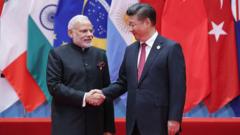India and China are cautiously moving towards reconciling their long-standing border disputes, though significant challenges remain in their bilateral relations.
India and China Seek Reconciliation Amidst Lingering Tensions

India and China Seek Reconciliation Amidst Lingering Tensions
As both nations seek to improve ties, complex geopolitical dynamics complicate their relationship.
In a notable shift towards improving relations, India and China have begun to explore paths to reconciliation following years of border skirmishes. Last month saw visits from senior Indian officials, including National Security Adviser Ajit Doval and Defence Minister Rajnath Singh, to China. Singh's visit marked the first engagement of its kind in five years and was seen as a potential thaw in the historically strained relationship.
The root of the ongoing tensions lies in the disputed 3,440 km (2,100-mile) border, where varying topographies and geographical features lead to often contentious confrontations. A notable escalation occurred in June 2020 during a clash in the Galwan Valley, resulting in the deaths of at least 20 Indian and four Chinese soldiers. Skirmishes in various territories have since heightened awareness of the fragile nature of peace along this border.
Despite the historical grievances, shifting geopolitical landscapes—the result of aspirations in the region and beyond—have encouraged dialogue between the two nations. They reached an agreement on major points of friction last year, followed by efforts to restore direct flights and lift visa restrictions early this year. Indian pilgrims were once again allowed access to major sites in the Tibetan region after a six-year hiatus.
However, experts caution that numerous hurdles lie ahead. For India, China remains a crucial trading partner, with bilateral trade hitting over $127 billion last year. Indian dependency on Chinese imports, particularly in strategic sectors like rare earth minerals, underscores the importance of stability along the border to facilitate economic growth. Conversely, China, which is focused on the stability of its border while attentively watching India's increasing alliances with Western nations, seeks economic cooperation with India amidst its own ambitions in regional markets.
Furthermore, the complexities of geopolitics introduced by factors such as U.S.-India relations and recent dealings between China and Pakistan further complicate reconciliation efforts. Past tensions, exacerbated by former President Trump’s comments suggesting mediation between India and Pakistan, have led to an atmosphere of mistrust in Delhi about the reliability of the U.S. as a partner amid uncertainty.
Amid these dynamic shifts, India is cautious but pragmatic; it recognizes the need to strengthen regional ties while being wary of appearing submissive to Chinese demands. The evolving relationship with Russia, long a strategic ally, also influences India's calculations, as concerns about Russia veering closer to China due to recent geopolitical strifes persist.
Compounding the complexity, recent Chinese restrictions on key exports, such as rare earth elements, have raised alarms in India, prompting the government to engage with Beijing for alleviation. As both nations navigate these pressures, they remain acutely aware of the unresolved territorial issues, especially the Chinese claims over Arunachal Pradesh, which India staunchly defends as an integral part of its territory.
For now, while India and China work towards a relationship that aims to mitigate future tensions, the prospect of complete resolution over their longstanding disputes remains a distant hope. Both nations appear willing to craft beneficial ties without reliance on external power dynamics while fostering pragmatic relations in light of their sovereignty concerns.





















